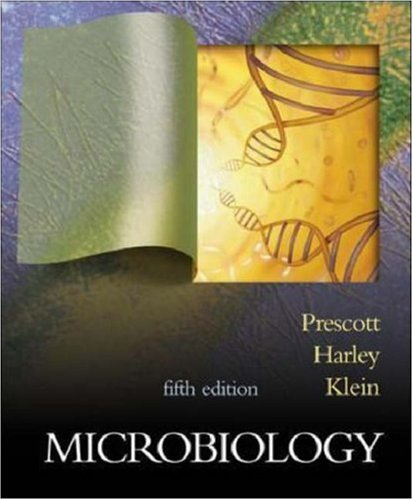📘 قراءة كتاب Microbiology, Fifth Edition أونلاين


علم الأحياء الدقيقة ، الإصدار الخامس من كتب علمية
يوفر الإصدار الخامس من بريسكوت وهارلي وكلاين مقدمة متوازنة وشاملة لجميع
المجالات الرئيسية لعلم الأحياء الدقيقة. بسبب هذا التوازن ، يعد علم الأحياء الدقيقة ، 5 / هـ مناسبًا للطلاب الذين
يستعدون لشغل وظائف في الطب وطب الأسنان والتمريض والصحة المساعدة ، فضلاً عن البحث والتدريس
والصناعة. علم الأحياء والكيمياء من المتطلبات الأساسية. تم تحديث الإصدار الخامس على
نطاق واسع ليعكس أحدث الاكتشافات في هذا المجال.
الجديد في هذا الإصدار
• تم تحديث كل فصل في الكتاب ليعكس أحدث الاكتشافات في علم الأحياء الدقيقة ، بما في ذلك
معلومات عن علم الجينوم والأغشية الحيوية وآليات السموم والتصنيف والأمراض الناشئة. أكثر
تمت مراجعة واسعة النطاق في مجالات علم الوراثة ، والبيئة الميكروبية ، وعلم المناعة حيث
تم تحديث المواد وإعادة تنظيمها للسماح باستخدام أسهل.
• فصل جديد في علم الجينوم: الفصل 15. تم إعادة تنظيم تغطية علم الوراثة من أجل الوضوح وسهولة
التدريس. ينتهي قسم علم الوراثة الآن بفصل جديد تمامًا عن علم الجينوم. الفصل الجديد 28 عن
تفاعلات الكائنات الحية الدقيقة والبيئة الميكروبية!
• برنامج فني مطور حديثًا - الكثير من الفن جديد أو منقح! إنه يشتمل على تناسق اللون والأسلوب
طوال الوقت حتى يتمكن الطلاب من تحديد موضوعات معينة بسهولة.
• تمت إضافة أسئلة جديدة للتفكير النقدي لتوفير الممارسة في تحليل البيانات والتنبؤ بالنتائج
ولتعليم الطلاب كيفية التفكير المنطقي.
• تم تعديل التنظيم العام للنص لتوفير تدفق منطقي أكثر للموضوعات ولإعطاء
تركيز أكبر على البيئة الميكروبية
علم الأحياء الدقيقة ،
ميزات الإصدار الخامس
• يحتوي كتاب بريسكوت المدرسي على فصول مختصرة أكثر من معظم الكتب ، ولكن أكثر منها (42). سيجد الطلاب
الفصول الموجزة أكثر قبولا وأقل تخويفًا. تتيح الفصول القصيرة للمدرس الفرصة لملاءمة
النص بشكل أقرب إلى منهج المعلم. يسمح بمرونة الموضوع.
• يوجد نظام تعليمي متميز يتضمن الخطوط العريضة والمفاهيم والمصطلحات الرئيسية والإحالات المرجعية
والقراءات وأسئلة التفكير النقدي الجديدة وما إلى ذلك لمساعدة الطلاب على فهم المواد الصعبة.
يوفر الإصدار الخامس من بريسكوت وهارلي وكلاين مقدمة متوازنة وشاملة لجميع المجالات الرئيسية لعلم الأحياء الدقيقة. بسبب هذا التوازن ، يعد علم الأحياء الدقيقة ، 5 / هـ مناسبًا للطلاب الذين يستعدون لشغل وظائف في الطب وطب الأسنان والتمريض والصحة المساعدة ، فضلاً عن البحث والتدريس والصناعة. علم الأحياء والكيمياء من المتطلبات الأساسية. تم تحديث الإصدار الخامس على نطاق واسع ليعكس أحدث الاكتشافات في هذا المجال.
وصف
لدورات في علم الأحياء الدقيقة التمهيدي.
تتضمن هذه الحزمة MasteringMicrobiology ™.
استثمر في مستقبلك: علم الأحياء الدقيقة مهم.
يُعرف الإصدار الخامس من كتاب Robert Bauman's Microbiology with Diseases by Taxonomy ، المعروف ببرنامجه الفني الفريد والفعال ، وأسلوب الكتابة التحاوري ، ومعلمي الفيديو الذي أنشأه المؤلف ، باستمرار سبب أهمية علم الأحياء الدقيقة ، لا سيما في مجال الرعاية الصحية. يوفر النص تجربة تعليمية متعددة الوسائط ومتوافقة مع الأجهزة المحمولة ، بدءًا من "المرض الجديد في النص في الاستكشافات المرئية المتعمقة" إلى البرامج التعليمية التفاعلية. تتيح رموز QR النصية الوصول الفوري إلى مجموعة موسعة من مقاطع الفيديو ، بما في ذلك 15 Video Tutor الجديدة و 6 حالات فيديو الرسوم المتحركة Micro Matters الجديدة. يقدم برنامج التقييم والواجب المنزلي MasteringMicrobiology المستخدم على نطاق واسع مجموعة أكبر من خيارات المهام مثل دروس الأحياء الدقيقة التفاعلية الجديدة ومعلمو الفيديو MicroBooster وأنشطة تدريب Connecting Concepts والمزيد.
إضفاء الطابع الشخصي على التعلم باستخدام إتقان علم الأحياء الدقيقة
MasteringMicrobiology هو عبارة عن واجب منزلي وبرنامج تعليمي ومنتج تقييم مصمم لتحسين النتائج من خلال مساعدة الطلاب على إتقان المفاهيم بسرعة. يستفيد الطلاب من البرامج التعليمية ذاتية السرعة التي تتميز بردود فعل خاطئة مخصصة وتلميحات تحاكي تجربة ساعة العمل وتساعد في إبقاء الطلاب على المسار الصحيح. من خلال مجموعة واسعة من الأنشطة التفاعلية والمشاركة والقابلة للتخصيص ، يتم تشجيع الطلاب على التعلم بنشاط والاحتفاظ بمفاهيم الدورة التدريبية الصعبة.
علم الأحياء الدقيقة ، الطبعة الخامسة
كتب ميكروبيولوجي مترجمة
ميكروبيولوجيا طبية pdf
كتب العلوم
كتب ثقافه علميه
https kutub me qrkxa0
تحميل كتب علمية بصيغة pdf
كتب pdf
كتب موثقة
حجم الكتاب عند التحميل : 144.2 ميجا بايت .
نوع الكتاب : pdf.
عداد القراءة:
اذا اعجبك الكتاب فضلاً اضغط على أعجبني و يمكنك تحميله من هنا:

شكرًا لمساهمتكم
شكراً لمساهمتكم معنا في الإرتقاء بمستوى المكتبة ، يمكنكم االتبليغ عن اخطاء او سوء اختيار للكتب وتصنيفها ومحتواها ، أو كتاب يُمنع نشره ، او محمي بحقوق طبع ونشر ، فضلاً قم بالتبليغ عن الكتاب المُخالف:
 قبل تحميل الكتاب ..
قبل تحميل الكتاب ..
يجب ان يتوفر لديكم برنامج تشغيل وقراءة ملفات pdf
يمكن تحميلة من هنا 'http://get.adobe.com/reader/'


 منصّة المكتبة
منصّة المكتبة